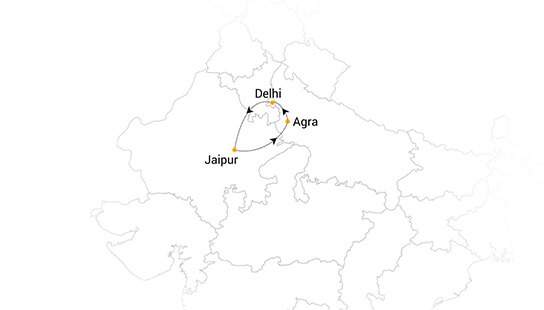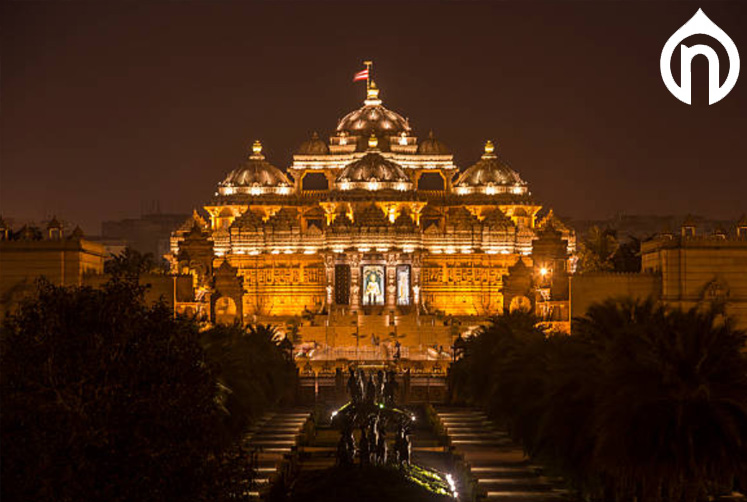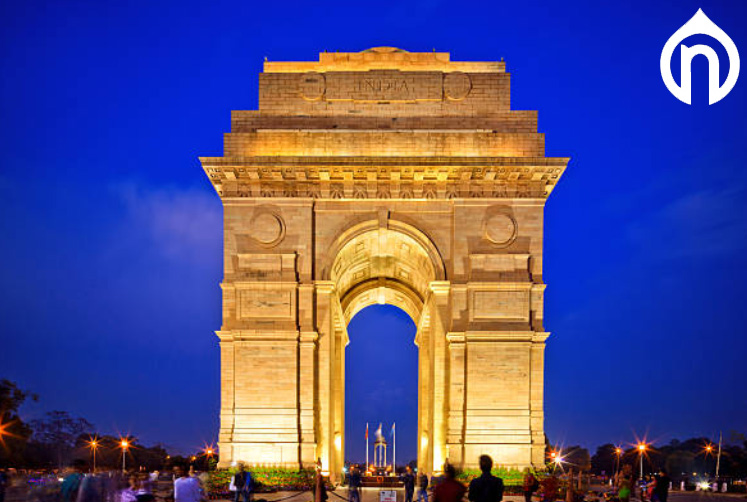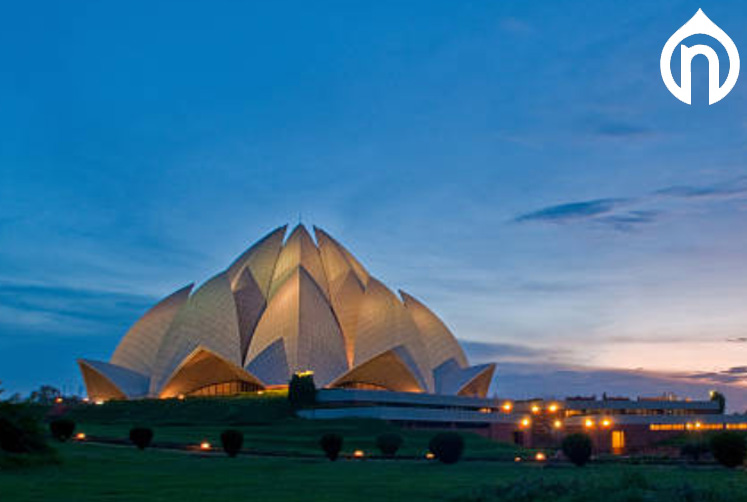
TOUR HIGHLIGHTS
- A complete all-inclusive tour with the best pricing with maximum quality of sightseeing.
- Stay in top quality of hotels.
- Daily buffet breakfast.
- Detailed tour of Old Delhi includes – Chandni chowk’s market, Jama Masjid, Red Fort, Rajghat etc
- Detailed tour of New Delhi includes – Qutab Minar, India Gate, President’s house, Parliament house etc
- Visit world famous Taj Mahal.
- Visit to famous Pink city includes – Amber Fort, Hawa Mahal, Astronomical Observatory – Jantar Mantar
ITINERARY
Arrive Delhi. Enjoy sights of Old and New Delhi comprises the sights of old Chandni Chowk to the New Delhi Haat.
Start your exciting tour to the land of colors – India. On arrival at Delhi airport, you will meet and be transferred to your pre-booked hotel. Here you stay for two nights. Your hotel is located in the heart of the city to give you the best timings to reach to all famous monuments and markets. There is much to see and do in Delhi,capital city of independent India. Seven cities have existed here since the 10th Century and it has been ruled over by Rajputs, Turks, Afghans, Mughals and the British. Delhi is two cities in one. The first is the Old Delhi of the Mughals, created by Shah Jahan and still, a medieval palace of forts, mosques, and bazaars whilst the second is New Delhi. After relax and fresh up, board your coach to explore Old and New Delhi, a city truly full of fascinating contrasts, where by day, temples are packed with the devout, and by night, hotel discos are packed with the affluent. Visit to Raj Ghat, the memorial to Mahatma Gandhi, built at the site of his cremation on the banks of the Yamuna River. Drive past the Red Fort and continue to the Jama Masjid, site of an exquisite mosque in red sandstone and marble. Completed in 1656 after six years of work by 5,000 laborers, it is considered one of the loveliest houses of worship in the world. This afternoon you will visit New Delhi, which reflects the legacy the British left behind. Whereas the walled old city is all tradition in all its facets, New Delhi is a city trying to live up to the best of 21st century standards. Your tour to New Delhi begins with a visit to the Qutub Minar, the 234-foot high tower made of sandstone, known as the seventh wonder of Hindustan and the tallest stone tower in India and a wonderful example of Indo-Islamic architecture, complete with terra-cotta frills. At its foot lies the Quwwat-ul-Islam Masjid, the first Muslim mosque in India erected in the 12th century on the site of a Hindu temple, from materials salvaged from 27 demolished Hindu and Jain shrines a monument built by Edwin Lutyens to commemorate the Indian soldiers who died in the World War and the Afghan Wars, to the Parliament building and the Rastrapathi Bhawan, the President's residence. Overnight at the hotel.
Meals : Breakfast ( ✔ )
Drive to Agra – house of the world famous The Taj.
After breakfast in the morning, drive to Agra. The city of love and devotion. Agra, the imperial capital of erstwhile Mughal Empire, is the city of unspeakable grandeurs. On arrival check into your pre-booked hotel. After freshen-up, we visit the world famous Taj. The Taj Mahal is considered to be the symbol of undying love. It is supposed to be a timeless beauty that depicts the splendor of a woman who truly loved her husband. Built over a time period of 22 years by the Mughal emperor Shah Jahan in the memory of his beloved wife Mumtaz Mahal, the Taj Mahal till date never fails to attract love-struck couples from far and wide. The Taj Mahal continues to enthrall not just visitors but also artists, painters, sculptors, poets, and photographers. Never has a monument been talked of so much that it appears in each and every aspect of art. The exquisite monument in white marble stands on the banks of the River Yamuna in Agra and looks picture perfect. It gives the word "perfection" an entirely new meaning. In fact, it is said that one must visit India just to see the Taj Mahal. One of the most famous symbols of tourism. At the end of the day, you will be satisfied with the experience, which is truly mind-blowing and one that you shall not forget for the rest of your life. Afterward, lose yourself in the local marble and leather markets where you should do your best to bargain for the marble products and high-quality leather wallets, shoes and belts. Be sure to visit the "Petra Dura Workshop" where you'll find beautiful marble inlay that is among the most renowned of India's handicrafts. During your visit enjoy an opportunity to watch as artisans create fine quality marble inlay pieces. Overnight at the hotel.
Meals : Breakfast ( ✔ )
Onto the famous Pink city, the capital of the state. The city full of color, culture, and monuments.
After breakfast this morning drive Jaipur. En route visits Fatehpur & Sikri to visit Agra Fort. Fatehpur Sikri is actually a historical capital city made out of twin village of Fatehpur and Sikri that are situated 45 odd kilometers from the city of Agra. The most interesting monument in the city is the mighty Buland Darwaza that guards the entrance of the Gate. As you enter the gate, Jama Masjid falls to your left. The beautifully carved tomb of Khwaza Salim Chisti is situated in the middle of the big square courtyard. As you take the right gate, Sikri fort falls on your left and so are Panch Mahal and Jodha Bai Palace. The architecture of all these buildings has a subtle blend of Hindu and Islamic architectural designs. Fatehpur Sikri has all these and much more. Also, visit Panch Mahal. Panch Mahal is basically a five-storied structure that can easily pass as an architectural marvel. Panch Mahal also signifies the undiluted imprint that Buddhism has left on the Indian psyche. This is proved by the fact that Panch Mahal is built on the Buddhist architectural style. Built on the pattern of a Buddhist Temple, Panch Mahal was basically a pleasure palace of emperor Akbar. He primarily used it for relaxation and entertainment purpose. At Sikri also visit Salim Chisti Tomb. Khwaza Salim Chisti was a Sufi saint of the Chisti order in 16th century India. The saint used to reside in the then dusty village of Sikri. It is said that Khwaza Salim Chisti blessed emperor Akbar with a son. The son was named Salim in reverence of the saint, who in the course of came to be known as Emperor Jahangir Jahandar. When Khwaza Salim Chisti died, he was buried in the same Sikri complex where he once resided. A tomb that is popularly called Mazaar in Hindustani was later commissioned that stands in the middle of the courtyard of the Jama Mosque in Sikri Fort Complex. The Naqqashi and Jaali work of this low-domed tomb has fewer parallels in India. Later in the evening, arrive and check into your pre-booked hotel. Later visit the Palace of Winds, the Hawa Mahal. Famous for its beehive like structure, the Mahal is an interplay of red and pink sand stone, carefully and painstakingly outlined with white borders and motifs, which served as an elaborate latticed facade behind which the cloistered ladies of the court used to watch the daily goings on in the street below. Overnight at the hotel.
Meals : Breakfast ( ✔ )
Visit Amber Fort.
After breakfast in the morning, visit the famous city known as Pink City because it was built of pink stucco in imitation of sandstone. This capital of the state of Rajasthan is a land of beauty, color, and paradox. Here you find invincible forts and magnificent palaces and gardens, waves of sand dunes and serene lakes. Except for the busy traffic of bicycles, cars, and buses, little seems to have changed. Jaipur was founded in 1727 by Maharaja Sawai Jai Singh II and is a marvelous synthesis of architectural influences that range from Hindu and Jain to Mughal. A well-planned city built from rose-colored terracotta that has given it a distinctive pink hue. Visit the ancient capital of Amber to see the fabulous Amber Fort. Amber Fort, begun in the 17th century by Maharaja Mansingh, Mughal Emperor Akbar's most successful General. The fort is surrounded by fortified battlements and overlooks the Moat Lake. Ruins and remains are spread over the Aravalli hills and sprawling crenulated walls lattice the surrounding area. Before the City Palace was constructed in Jaipur, Amber was the seat of power. Ascend to the fortress by jeep or elephant (if available) to view the sprawling complex of courtyards and halls, many of them hung with magnificent wall paintings and some inlaid with precious stones and mirrors. In the Sheesh Mahal – Hall of Mirrors – a single lamplight is reflected in the many mirrors lighting up the entire room. This afternoon, return to the city of Jaipur. Highlights of this afternoon touring include the City Palace, an overwhelming complex of exquisite palaces, gardens and courtyards, decorative art and carved doorways. The City Palace Museum houses collections of rare manuscripts, armor, costumes, carpets and miniature paintings. Walk to the adjacent Jantar Mantar (Astronomical Observatory), a collection of architectural astronomical instruments, built by Maharaja Jai Singh II at his then new capital of Jaipur between 1727 and 1733. The observatory instruments are in most cases huge structures, built on such scale so that accuracy of readings can be obtained. The samrat yantra, for instance, which is a sundial, can be used to tell the time to an accuracy of about a minute. The remainder of the day to wander about the local markets where you will find lovely silver jewelry, handicrafts and roadside mehndiwala (henna painters) who will paint ladies hands in the local tradition. Overnight at the hotel.
Meals : Breakfast ( ✔ )
Fly back Home.
After breakfast check out and proceed to Delhi international airport to catch your flight back to Home. Arrive Home with pleasant memories of your India tour, which we sure you will treasure of a lifetime. Your valued suggestions are highly appreciated.
Meals : Breakfast ( ✔ )
INCLUSION
Inclusion
- Accommodation using Starting Room Category of Each Hotel on Twin Sharing Basis.
- Daily Breakfast as per the above package in the hotel.
- Service of an English speaking guide during sightseeing.
- Airport Transfers & sightseeing as per the itinerary by Air – Conditioned Vehicle.
Exclusion
- Personal expenses such as mini bar , travel insurance , laundry, telephone calls , spa , tips , porter-age , etc.
- Additional sightseeing or extra usage of the vehicle, other than mentioned in the itinerary.
- Still camera or Video camera fee .
- Any cost arising due to natural calamities like, landslides, road blockage, political disturbances (strikes), etc. to be borne by the client directly.
- Any other feature which is not mentioned in the "Cost includes" column.
- Government Service Tax.
- Airports tax and travel insurance etc.
COST
PRICE
| Category | Per Person | Extra Adult | Extra Child |
|---|---|---|---|
| Standard | USD 506 | USD 456 | USD 354 |
| Deluxe | USD 558 | USD 503 | USD 391 |
HOTELS
| Place | Nights | Deluxe | Standard | Meal Plan |
|---|---|---|---|---|
| Delhi | 01 | Shervani Nehru Place | Evoke Lifestyle | Breakfast Only |
| Agra | 01 | Hotel Mansingh | Howard Plaza | Breakfast Only |
| Jaipur | 02 | Regenta Central | Hotel Mansingh | Breakfast Only |
NOTE: Rooms are subject to availability, we will provide alternate hotels if above hotels are not available.
TERMS
- Confirmation will be received at time of booking
- A current valid passport is required on the day of travel
- English-speaking guide. If you need another language then kindly inform us in Special Requirements upon booking
- The duration of transfers are approximate; the exact duration will depend on the time of day and traffic conditions
- Avoid any clothing that is too revealing
- The accommodation room type (single room, double room or triple room) will depend on the availability of the hotels and the room configurations available, especially for odd-numbered groups of traveler






